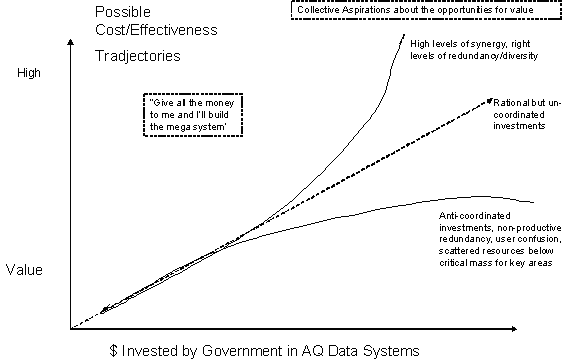AQ Data System Strategy Introduction and Purpose
Back to < Community Air Quality Data Systems Strategy
AQ Data System Strategy Introduction and Purpose
Chapter text here.
Comments from Data Summit
Chet Wayland (EPA OAQPS) and Rich Scheffe (EPA OAQPS) welcomed participants and reviewed the purpose of the data summit:
- to convene organizations and individuals with key roles in retrieving, storing, disseminating, and analyzing air quality data in order to learn about and explore efficient means of leveraging the numerous individual efforts underway;
- to assist EPA/OAQPS in honing its role in the larger air quality data community;
- to begin to establish a community-wide strategy responsive to user defined needs.
Re-stating context for the meeting. Comments in this section were provided as a summation of issues from day one by the facilitator as a point of departure for discussion. Opinions in this section to not necessarily represent those of any individual participant, they are provided for discussion purposes only.
EPA, NOAA, NASA and other funders are now, and will continue to make funding decisions, many of which have implications for projects of their peer agencies and implications across many of the air quality communities’ areas of interest. They are making these decision without an over-arching vision of the system of these systems. Most of the attendees of this meeting will be directly/indirectly effected by these decisions.
We expect that that funding for air quality related projects is likely to be declining or stable. We posit that there is a wide range of cost-effectiveness trajectories for these investments. Fig 1 provides a sketch of these possibilities. They include the lower trajectory of anti-coordinated investments, the linear trajectory of rational but not coordinated investments, and the “idea” trajectory where smarter investments yield high cost effectiveness. The NW quadrant depicts only for the purposes of discussion, the rational but unrealistic sentiment that if all spending were centralized somehow in one/small number of ideal systems there would be high cost effectiveness.

Figure 1 Possible Cost Effectiveness Trajectories
Question for this session is “With what vision (of some system of systems) should those funding decisions be guided and informed?” And how should that same vision inform the implementation activities of the funding recipients?
Thus current budget climate presents both a dilemma and an opportunity. The dilemma, is that without such an over-arching, user-community credible vision, funding agencies have to resort to a “pick the big winners” strategy, and do so on the basis of limited information, and feedback from user community.
Opportunity, around which this conference was organized, is that, through some new forms of collaboration and coordination among all the partners in the data value chain, a credible vision for a system of systems could be established, and used by funders and implementers to dramatically improve the efficiency and performance of the overall air quality value chain. Further this credible vision would position funding agencies to make more persuasive and successful request for resources (including joint requests which could be especially powerful).